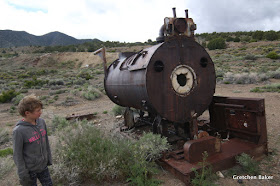It was a rather tumultuous afternoon when Desert Girl and I pulled over along Utah Highway 21, about 15 miles west of Milford, Utah, to visit the ghost town of Frisco. Frisco was a boom-and-bust mining town, which at its height in the 1880s had 6,000 people living there. Amazingly, there are no streams, lakes, springs, or wells in the nearby area. Water had to be brought in for all those people. And perhaps that's part of the reason it had a reputation for being such a rough place. Why pay for water when you could drink whiskey?
Frisco started soon after two prospectors, James Ryan and Samuel Hawks, found ore in September 1875. They staked a claim, but soon sold it, thinking it would be small. (They had been working in a nearby mine in the San Francisco mountains, so perhaps they were basing their knowledge on that mine.) It turned out this ore body was large, producing 25,000 tons of ore, with high silver content, in the next few years. Nearby, the Horn Silver Mine was also found in 1875. It turned out to be the largest producer in the area. In 1877, five charcoal kilns were built to help with the smelting process. In June 1880, the Utah Southern Railroad Extension arrived in Frisco, making it even easier to ship in supplies and ship out ore. 1880 was also when the Southern Utah Times newspaper began publication, lasting over eight years. It was described as: “The Southern Utah Times is a wide-awake, pithy, gentile sheet.”
When miners reported for duty on February 12, 1885, they were told to wait because there were tremors. The night shift emerged. And then there was a massive collapse down to the seventh level, closing off the richest part of the ore. Fortunately no one was killed, although tremors were felt as far away as Milford. Mining eventually resumed, but at a smaller scale.
Frisco gained a reputation as one of the wildest places in the West. It was known for numerous murders, with a cart assigned to pick up bodies and cart the off to boot hill for burial.
We visited the cemetery, which painted a very different picture of Frisco. Instead of marked graves of criminals, or even adult-aged dead, we found a cemetery full of children's graves. It must have been a hard life out in the mining town. (One account I read said that heavy metals in the water contributed to the high child mortality.)
In the background you can see the main mining area, the Horn Silver Mine. Copper, gold, and other minerals were also found.
With a telephoto lens, we could see the tailings and a big hole in the rock.
But we couldn't get any closer, as the roads are blocked off and No Trespassing signs are posted.
We took a road that was open, but eventually it was blocked with this huge tank.
So we headed off in a different direction, eventually realizing that we were driving on the old railroad tracks. A spur from Milford had been built to Frisco, and later to Newhouse, a mining area around the mountain that reached its peak a couple decades later.
Soon we found what we were looking for--five charcoal ovens.
The fence around them has long been broken through. Unfortunately some people aren't so respectful of the charcoal ovens, which have been placed on the National Register of Historic Places. (Click the link to learn more about the materials they were built with.) Despite their condition, they are still among the best preserved charcoal kilns in the state of Utah. We found evidence of campfires in several.
Of course, the charcoal ovens were built with the intention of fires in them. The reason for charcoal ovens is to turn wood into charcoal, which can burn at a higher temperature and longer, which is very useful in smelting, an important process in mining.
As the sun started to come out, I wandered around looking for interesting views of the ovens. I found that on the backside, bricks had been used. I have no idea why.

A bit of paintbrush added some color to the scene. Beyond the ovens are remnants of the town of Frisco.
As far as the town of Frisco goes, many building fragments remain.
We also found this old boiler.
In addition to the old rocks and wood in the buildings, there is a new arrival: the invasive weed whitetop. It wasn't known when Frisco was inhabited, but unfortunately has moved in now.
We enjoyed our quick visit to Frisco. There is so much more to explore here. And with the rich history, you can certainly imagine some of what happened in this ghost town. A great website with lots more info about Frisco is http://thetrekplanner.com/frisco-utah/
















No comments:
Post a Comment
Hi, I love to read your comments! I've recently decided to turn off word verification to make it easier to leave comments, but in doing so, I'm only accepting registered users to avoid spam. You can also leave comments on the Desert Survivor Facebook page. Thanks!